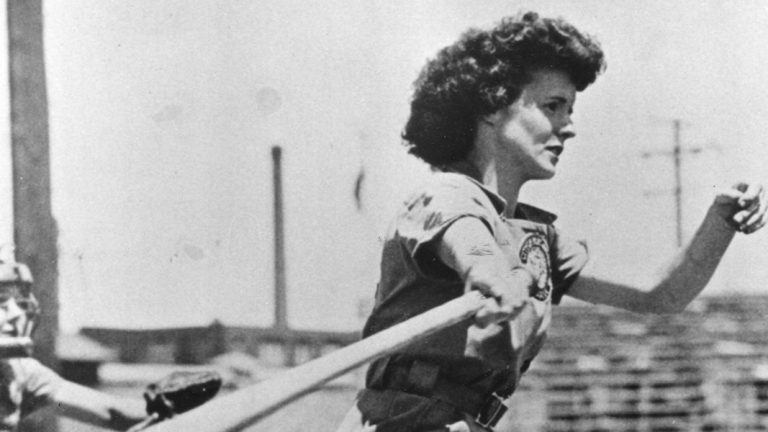TORONTO – Casey Candaele never made much of it growing up, the way his mother Helen moved so athletically around a diamond as she taught him how the game, her occasional mentions of playing ball back in the day.
“I just thought everybody’s mom was out there throwing BP, hitting groundballs and playing catch. It was like, this is what everybody does,” says the former utilityman with the Montreal Expos, Houston Astros and Cleveland who now manages triple-A Buffalo in the Toronto Blue Jays system. “She was a very, very, very humble woman and never talked in depth about her playing. As a kid, it was just, well, my mom is pretty good at baseball.”
Eventually, the trail of hints she dropped over the years prompted Kelly, one of her five sons, to dig into her past and discover that not only did she play some ball, but that she starred in the All-American Girls Professional Baseball League during the 1940s. He became so intrigued that he and Kim Wilson put together a documentary entitled A League of Their Own, which inspired the 1992 Penny Marshall movie of the same name starring Tom Hanks and Geena Davis.
Helen Callaghan, as the late Vancouver-born outfielder was then known, played five seasons with Minneapolis, Fort Wayne and Kenosha, led the league with a .299 average in 1945, stole 419 bases in 495 career games and finished with a .355 on-base percentage. Some retroactive recognition of her career and accomplishments comes Nov. 16, when she’ll be inducted into the Canadian Baseball Hall of Fame as part of a 2021 class featuring significant contributors to the game’s history in the country.
She’ll be the first woman inducted individually – in 1998, all 69 Canadian women to play in the AAGPBL, including Helen’s older sister Marge, were enshrined as a group.
“This is really, really cool, and she would be really flattered, amazed and really appreciative of that,” says Casey, the youngest of her sons. “The women who played baseball in those times, having to do it in a certain way because of how society viewed it, were pretty ground-breaking. I don’t think she thought of it at the time, but then to look back, it was pretty special for her and for all the women to be playing baseball in an era where men were the dominant athletes.
“They did an unbelievable job of pushing women’s sports forward. It took a while, but they got deserved recognition. It’s just really cool that they’re finally viewed as great athletes playing baseball, playing the game the right way, playing hard.”
Adds Kelly: “She was kind of a shy person and not that talkative about her playing days. But when People magazine came by our house and we went on the Today show with Bryant Gumbel (after the movie came out), it started to hit her that she had participated in a really amazing experience and the league was really fascinating to people.”
Part of the reason for the fascination then was because the AAGPBL had essentially been forgotten as the women who played in it moved on from the game and started their lives.
The loop was founded by former Chicago Cubs owner Philip K. Wrigley during the Second World War and ran from 1943-1954 with as many as 10 teams in the American Midwest, drawing some 900,000 fans during its peak.
The Callaghan sisters were softball stars in Vancouver and were scouted during a 1943 tournament in Detroit. Helen earned an invitation to the league’s spring training in 1944, was allocated to Minneapolis and eventually her father Albert encouraged Marge to join her to help keep watch on her. In. 1945, the team moved to Fort Wayne and the sisters played three years together there, and Helen played one more season in Kenosha in 1949.
Casey, Kelly and their three brothers only learned of her exploits through the occasional tidbits she’d drop, an “I used to play baseball,” here, a “that time in Pascagoula, Mississippi,” there.
There were a few old gloves around the house and a few pictures, but nothing that screamed out, “you need to look into this,” says Kelly. Once he finished university with a Master’s in psychology, he took a historian’s approach into researching both his mom and the league, finding loads of video at the national archives in Washington, D.C., from old news reels that used to play in theatres before movies.
Along with old news clippings, Kelly was stunned to learn how impactful the league was and about his mother’s role in the loop. He produced a three-minute brief on the AAGPBL for a local PBS station and it grew into the documentary that was fictionalized for the movie.
“I really didn’t realize the significance of what my mom’s little stories until I saw this old footage and realized what great athletes these women were, especially my mom,” says Kelly. “This was more than a kind of novelty act. It was a serious business.
“These kinds of things happen in history sometimes, when people go, ‘Wow, that took place back then? That’s a really unique story. Why was it never widely known?’”
Kelly described Helen as “a player of many threats,” who could hit, run and play defence. The latter two need to be emphasized since Wrigley insisted the women wear short-skirted uniforms that exposed their legs from a palm-above-the-knee down, which regularly led to raspberries on their calves and thighs.
In a nod to the social mores of the times, the women were expected to behave like proper ladies off the field – they travelled team chaperones to monitor behaviour – and compete fiercely on it, something Helen excelled at.
“She did in an era when really women weren’t doing those kind of things – it’s pretty spectacular,” says Casey, whose playing career made him and Helen the only mother-son pro ball duo. “They played the game the right way, played hard and they had to do it all in skirts, so pretty impressive.”
Indeed, and both brothers believe their mother would be thrilled with the growth of women’s sports in recent years, and the push to increase funding for further development.
It’s something Helen wouldn’t have envisioned back in her day, despite her professional career, and why she would have been so grateful for her posthumous place in the Canadian Baseball Hall of Fame in St. Marys, Ont. She died from breast cancer at the age of 69 in 1992.
“She loved the growth of women’s sports because she understood what we all know, that they’re just as competitive, just as as dedicated and disciplined and determined to develop their athletic abilities to the highest level as men,” says Kelly. “She would be certainly proud and feel a sense of gratitude to the Canadian Baseball Hall of Fame for being inducted, humble about it but nonetheless thankful and appreciative.”
[relatedlinks]






COMMENTS
When submitting content, please abide by our submission guidelines, and avoid posting profanity, personal attacks or harassment. Should you violate our submissions guidelines, we reserve the right to remove your comments and block your account. Sportsnet reserves the right to close a story’s comment section at any time.